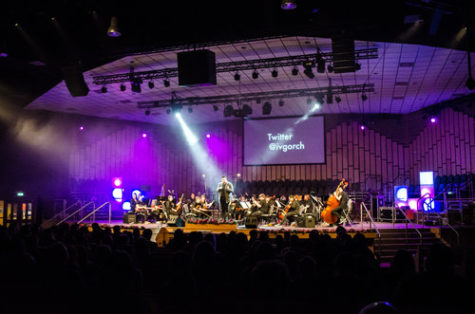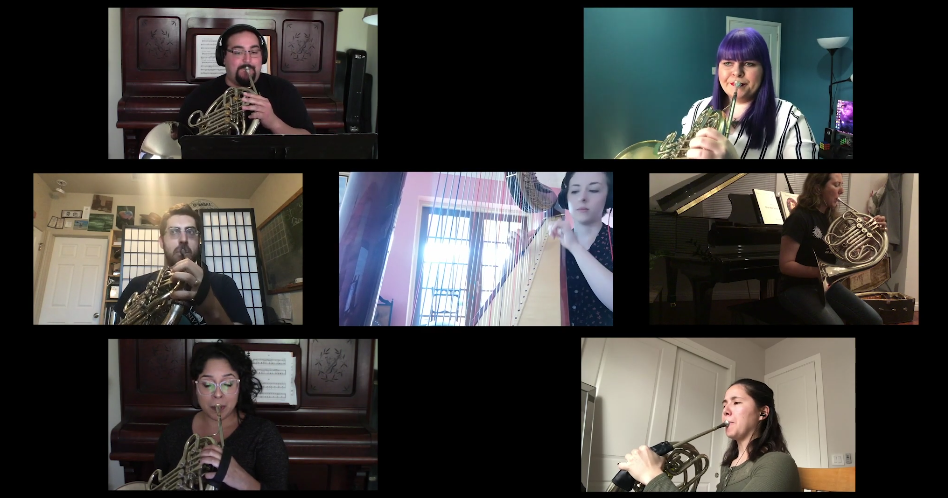
The vibrations created by the live performance of Long Beach State’s Studio Orchestra is an otherworldly experience.
As Robert Luke Martin, music director and founder, waves his hands in time, the brass section gradually swells. One by one, sections from strings to percussion are cued, collectively taking audiences through a series of twists and turns in the form of sound.
But, performing arts ensembles like Studio Orchestra at the Bob Cole Conservatory of Music were forced to find alternative means of creating and performing for audiences after the cancellation of face-to-face instruction.
“It’s a total bummer,” Martin said. “I love a live show, I really do.”

Studio Orchestra turned to click-track recording, a recording program technique that uses a metronome to help keep musicians on time when playing.
It requires musicians to film themselves playing their instrument and record the sound. Then, the audio clip is used to inform other performers on where and how to fit within the composition. The final compiled recordings are paired with visuals from the scored film, video game or animation. The product is a crisp, clean composition with fluid editing for viewers.
Students in Studio Orchestra are now more exposed to the technical side of composing music like audio mixing, the process of collecting various sounds and blending them in a way that’s harmonious, a key component for the track’s quality.
“It’s a huge part of the industry these days for individual musicians to record from a home studio and then send in their tracks,” Martin said. “A lot of soundtracks and film scores are done this way now.”
Studio Orchestra president Katie McNamara, a fourth-year string bass performance and film and electronic arts major, said that the ensemble has experimented with click-tracks in the past, which is why the technique felt natural to her.
Still, this method has its challenges.
“It does take, unfortunately, a bit more time for all of us to be able to put one performance out this year than it used to,” McNamara said. “Of course, it’s a bummer not being able to see everybody and react to the music live, but we’re also getting a bunch of incredible skills that will help us later in life.”
While musicians have more time to prepare to record before click-track sessions begin, McNamara said recording from home can be a tricky task due to background noise and space.
She said that this new creative space leaves room for vulnerability.
When McNamara played with the ensemble, she said that fitting in sonically could be an issue and mistakes could be disregarded.
That changed when performers began to record alone.
“When you’re playing by yourself, you have no ability to hide mistakes,” McNamara said. “It keeps you a lot more honest about your playing, so I think it makes you a little bit of a better player in that sense.”
Martin said that what the orchestra lacks this year are the audience reactions and the energy the musicians feed off. The orchestra strived to break down the fourth wall between the audience and the ensemble.
“It’s much harder to gauge what the audience is saying,” Martin said.
In July, the Irish Video Game Orchestra and Studio Orchestra came together virtually to play “Test Drive,” one of the compositions from the animated feature film “How To Train Your Dragon.”
Spring 2020 graduate and oboist Georgette Patricio was one of the collaborators in the Studio Orchestra.
“I was already familiar with the music since I have performed it with a different ensemble live prior to this specific project,” Patricio said in an email. “But the amount of time it took to learn how to record and trying to capture that perfect take was long and at the same time exhilarating.”
Martin said that the non-classical compositions, which range from video games to animation, are something his musicians and audiences genuinely appreciate. As music director, Martin selects the scores and soundtracks in addition to bouncing ideas off of the ensemble.
“We have, especially the audiences, a lot more emotional ties to the music already than say a Bach sonata,” McNamara said. “You might really like it, but not everyone in the audience played that video game and had very deep memories of playing it as a child or as an adult watching that series with your friends. So adding an emotional connection to the music already, I think it definitely brings a lot of fun to the concerts.”
In September, CSULB President Jane Close Conoley confirmed that spring 2021 will continue with virtual instruction.
While the ensemble continues to push for new ways to use technology for orchestral output, Martin hopes to have socially distant recording sessions next semester.
“That would be the dream idea,” Martin said.
This article previously contained an incorrect title of an orchestra and its location. A correction was made on Oct. 20 at 3:19 p.m.





Pingback: Lights off at Bob Cole: An in-depth look at how the department is operating amid a pandemic - Daily Forty-Niner